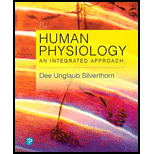
Human Physiology: An Integrated Approach (8th Edition)
8th Edition
ISBN: 9780134605197
Author: Dee Unglaub Silverthorn
Publisher: PEARSON
expand_more
expand_more
format_list_bulleted
Concept explainers
Question
Chapter 15, Problem 20RQ
Summary Introduction
Introduction: Blood transports different types of molecules from one part of the body to another. Some of these molecules are important for one or other part of the body to function properly but can be harmful also if present in higher amounts.
Summary Introduction
To determine: The cholesterol carrier lipoprotein that is harmful when present in higher amounts in blood.
Introduction: Cholesterol is transported throughout the body by the blood. Special carrier molecules, the lipoproteins, are present in the blood for carrying cholesterol from one part of the body to another. There are different forms of lipoproteins in blood that carry cholesterol.
Expert Solution & Answer
Want to see the full answer?
Check out a sample textbook solution
Students have asked these similar questions
Give only the mode of inheritance consistent with all three pedigrees and only two reasons that support this, nothing more, (it shouldn't take too long)
O
Describe the principle of homeostasis.
Chapter 15 Solutions
Human Physiology: An Integrated Approach (8th Edition)
Ch. 15.2 - Would you expect to find valves in the veins...Ch. 15.2 - Prob. 2CCCh. 15.2 - Who has the higher pulse pressure, someone with...Ch. 15.2 - The formula given for calculating MAP applies to a...Ch. 15.2 - Prob. 5CCCh. 15.3 - Resistance to blood flow is determined primarily...Ch. 15.3 - Prob. 7CCCh. 15.3 - Prob. 8CCCh. 15.3 - Skeletal muscle arterioles have both - and...Ch. 15.4 - Prob. 10CC
Ch. 15.4 - Prob. 11CCCh. 15.5 - Prob. 12CCCh. 15.5 - In the classic movie Jurassic Park, Dr. Ian...Ch. 15.6 - A man with liver disease loses the ability to...Ch. 15.6 - Prob. 15CCCh. 15.7 - Prob. 16CCCh. 15.7 - Malnourished children who have inadequate protein...Ch. 15 - Prob. 1RQCh. 15 - Prob. 2RQCh. 15 - Prob. 3RQCh. 15 - Prob. 4RQCh. 15 - Prob. 5RQCh. 15 - Prob. 6RQCh. 15 - List the factors that aid venous return to the...Ch. 15 - Prob. 8RQCh. 15 - Prob. 9RQCh. 15 - Prob. 10RQCh. 15 - Prob. 11RQCh. 15 - Most systemic arterioles are innervated by the...Ch. 15 - Match each event in the left column with all...Ch. 15 - Which organs receive more than two-thirds of the...Ch. 15 - By looking at the density of capillaries in a...Ch. 15 - Prob. 16RQCh. 15 - Prob. 17RQCh. 15 - Define edema. List some ways in which it can...Ch. 15 - Prob. 19RQCh. 15 - Prob. 20RQCh. 15 - Calcium channel blockers prevent Ca2+ movement...Ch. 15 - Prob. 22RQCh. 15 - Prob. 23RQCh. 15 - Define myogenic autoregulation. What mechanisms...Ch. 15 - Left ventricular failure may be accompanied by...Ch. 15 - Robert is a 52-year-old nonsmoker. He weighs 180...Ch. 15 - The following figure is a schematic representation...Ch. 15 - Prob. 28RQCh. 15 - Draw a reflex map that explains Anthonys vasovagal...Ch. 15 - Prob. 30RQCh. 15 - Prob. 31RQCh. 15 - Prob. 32RQCh. 15 - Prob. 33RQCh. 15 - Prob. 34RQCh. 15 - Prob. 35RQCh. 15 - Prob. 36RQCh. 15 - Prob. 37RQCh. 15 - Prob. 38RQCh. 15 - Prob. 39RQ
Knowledge Booster
Learn more about
Need a deep-dive on the concept behind this application? Look no further. Learn more about this topic, biology and related others by exploring similar questions and additional content below.Similar questions
- Explain how the hormones of the glands listed below travel around the body to target organs and tissues : Pituitary gland Hypothalamus Thyroid Parathyroid Adrenal Pineal Pancreas(islets of langerhans) Gonads (testes and ovaries) Placentaarrow_forwardWhat are the functions of the hormones produced in the glands listed below: Pituitary gland Hypothalamus Thyroid Parathyroid Adrenal Pineal Pancreas(islets of langerhans) Gonads (testes and ovaries) Placentaarrow_forwardDescribe the hormones produced in the glands listed below: Pituitary gland Hypothalamus Thyroid Parathyroid Adrenal Pineal Pancreas(islets of langerhans) Gonads (testes and ovaries) Placentaarrow_forward
- Please help me calculate drug dosage from the following information: Patient weight: 35 pounds, so 15.9 kilograms (got this by dividing 35 pounds by 2.2 kilograms) Drug dose: 0.05mg/kg Drug concentration: 2mg/mLarrow_forwardA 25-year-old woman presents to the emergency department with a 2-day history of fever, chills, severe headache, and confusion. She recently returned from a trip to sub-Saharan Africa, where she did not take malaria prophylaxis. On examination, she is febrile (39.8°C/103.6°F) and hypotensive. Laboratory studies reveal hemoglobin of 8.0 g/dL, platelet count of 50,000/μL, and evidence of hemoglobinuria. A peripheral blood smear shows ring forms and banana-shaped gametocytes. Which of the following Plasmodium species is most likely responsible for her severe symptoms? A. Plasmodium vivax B. Plasmodium ovale C. Plasmodium malariae D. Plasmodium falciparumarrow_forwardStandard Concentration (caffeine) mg/L Absorbance Reading 10 0.322 20 0.697 40 1.535 60 2.520 80 3.100arrow_forward
- please draw in the answers, thank youarrow_forwarda. On this first grid, assume that the DNA and RNA templates are read left to right. DNA DNA mRNA codon tRNA anticodon polypeptide _strand strand C с A T G A U G C A TRP b. Now do this AGAIN assuming that the DNA and RNA templates are read right to left. DNA DNA strand strand C mRNA codon tRNA anticodon polypeptide 0 A T G A U G с A TRParrow_forwardplease answer all question below with the following answer choice, thank you!arrow_forward
arrow_back_ios
SEE MORE QUESTIONS
arrow_forward_ios
Recommended textbooks for you
- Understanding Health Insurance: A Guide to Billin...Health & NutritionISBN:9781337679480Author:GREENPublisher:Cengage
 Human Physiology: From Cells to Systems (MindTap ...BiologyISBN:9781285866932Author:Lauralee SherwoodPublisher:Cengage Learning
Human Physiology: From Cells to Systems (MindTap ...BiologyISBN:9781285866932Author:Lauralee SherwoodPublisher:Cengage Learning

Understanding Health Insurance: A Guide to Billin...
Health & Nutrition
ISBN:9781337679480
Author:GREEN
Publisher:Cengage

Human Physiology: From Cells to Systems (MindTap ...
Biology
ISBN:9781285866932
Author:Lauralee Sherwood
Publisher:Cengage Learning




Nutrition and Diet - GCSE Biology (9-1); Author: Mr Exham Biology;https://www.youtube.com/watch?v=SFE1DfAlipo;License: Standard Youtube License